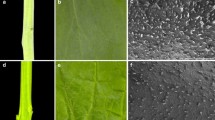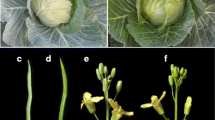Abstract
Cuticular wax is a complex mixture of very-long-chain fatty acid derivatives. The wax on the surface of plants serves as a protective barrier to reduce non-stomatal water loss and environmental damage. However, the loss of wax may lead to a glossy phenotype, which is an favorable trait in leafy vegetables. The mechanism of glossy mutants in non-heading Chinese cabbage (Brassica rapa L. var. communis) has not been studied yet. In this study, scanning electron microscopy (SEM) showed that the cuticular wax on the leaves and stem of a glossy mutant was dramatically reduced compared with that of the wild-type plant. Transmission electron microscopy (TEM) revealed that the cuticle ultrastructure of glossy mutant leaf and stem were altered when compared with the wild type. A cuticle wax analysis showed the total wax content of leaves, as well as alkanes, ketones and alcohols, was decreased. A genetic analysis indicated that the glossy phenotype was controlled by a single gene. Based on a homology analysis, the Brcer1 gene was identified as the candidate gene controlling the glossy phenotype. In the glossy mutant, a 39-bp deletion leads to an mRNA disruption and reduces the expression of the BrCER1 gene. Sequence analysis showed that a loss of function mutation in the Brcer1 gene was different from that of Cgl1, which was previously shown to be responsible for the glossy phenotype in B. oleracea, showing typical parallel selection. These findings provide a better understanding of the cuticular wax biosynthesis pathway and offer important information for molecular-assisted breeding of non-heading Chinese cabbage (B. rapa L. var. communis).



Similar content being viewed by others
References
Aarts MGM, Keijzer CJ, Stiekema WJ et al (1995) Molecular characterization of the CER1 gene of Arabidopsis involved in epicuticular wax biosynthesis and pollen fertility. Plant Cell 7:2115–2127
Adamski NM, Bush MS, Simmonds J et al (2013) The inhibition of wax1 locus (lw1) prevents formation of beta- and OH-beta-diketones in wheat cuticular waxes and maps to a sub-cM interval on chromosome arm 2BS. Plant J 74:989–1002
Baker EA (1982) Chemistry and morphyology of plant epicuticular waxes In: Cutler DJ, Alvin KL, Price CE (eds) The plant cuticle. Academic Press, London, pp 139–165
Bernard A, Domergue F, Pascal S, Jetter R et al (2012) Reconstitution of plant alkane biosynthesis in yeast demonstrate that Arabidopsis ECERIFERUM1 and ECERIFERUM3 are core components of a very-long-chain alkane synthesis complex. Plant Cell 24:3106–3118
Bird D, Beisson F, Brigham A et al (2007) Characterization of Arabidopsis ABCG11/WBC11, an ATP binding cassette (ABC) transporter that is required for cuticular lipid secretion. Plant J 52:485–498
Bourdenx B, Bernard A, Domergue F et al (2011) Overexpression of Arabidopsis ECERIFERUM1 promotes wax very-long-chain alkane biosynthesis and influences plant response to biotic and abiotic stresses. Plant Physiol 156:29–45
Burow GB, Franks CD, Acosta-Martinez V, Xin ZG (2009) Molecular mapping and characterization of BLMC, a locus for profuse wax (bloom) and enhanced cuticular features of sorghum (Sorghum bicolor (L.) Moench.) Theor Appl Genet 118:423–431
Chalhoub B, Denoeud F, Liu S, Parkin IA et al (2014) Early allopolyploid evolution in the post-Neolithic Brassica napus oilseed genome. Science 345:950–953
Chen XB, Mark Goodwin S, Boroff VL, Liu XL, Jenks MA (2003) Cloning and characterization of WAX2 gene of Arabidopsis involved in cuticle membrane and WAX production. Plant Cell 15:1170–1185
Doyle JJ, Doyle JL (1990) Isolation of plant DNA from fresh tissue. Focus 12:13–15
Fiebig A, Mayfield JA, Miley NL, Chau S, Fischer RL, Preuss D (2000) Alteration in CER6, a gene identical to CUT1, differentially affect long-chain lipid content on the surface of pollen and stems. Plant Cell 12:2001–2008
Gan L, Wang X, Cheng Z, Liu L et al (2016) Wax crystal-sparse leaf 3 encoding a β-ketoacyl-CoA reductase is involved in cuticular wax biosynthesis in rice. Plant Cell Rep 35:1687–1698
Girard A-L, Mounet F, Lemair-Chamley M et al (2012) Tomato GDSL1 is required for cutin deposition in the fruit cuticle. Plant Cell 24:3119–3134
Hannoufa A, Negruk V, Eisner G et al (1996) The CER3 gene of Arabidopsis thaliana is expressed in leaves, stems, roots. Flowers and apical meristems. Plant J 10:459–467
Haslam TM, Manas-Fernandez A, Zhao LF, Kunst L (2012) Arabidopsis ECERIFERUM2 is a component of the fatty acid elongation machinery required for fatty acid extension to exceptional lengths. Plant Physiol 160:1164–1174
Holmes MG, Keiller DR (2002) Effects of pubescence and waxes on the reflectance of leaves in the ultraviolet and photosynthetic wavebands: a comparison of a range of species. Plant Cell Environ 25(1):85–93
Hooker TS, Millar AA, Kunst L (2002) Significance of the expression of the CER6 condensing enzyme for cuticular wax production in Arabidopsis. Plant Physiol 129:1568–1580
Islam MA, Du H, Ning J, Ye H, Xiong L (2009) Characterization of Glossy1-homologous genes in rice involved in leaf wax accumulation and drought resistance. Plant Mol Biol 70:443–456
Jeffree CE (2006) The fine structure of the plant cuticle. In: Riederer M, Müller C (eds) Biology of the plant cuticle. Blackwell, Oxford, pp 11–125
Jenks MA, Eigenbrode SD, Lemieux B (2002) Cuticular waxes of Arabidopsis. In: Somerville CR, Meyerowitz EM (eds) The Arabidopsis book. American Society of Plant Biologists, Rockville
Jung KH, Han MJ, Lee DY, Lee YS, Schreiber L, Franke R, Faust A, Yephremov A, Saedler H, Kim YW, HwangI AG (2006) Wax-Deficient anther1 is involved in cuticle and wax production in rice anther walls and is required for pollen development. Plant Cell 18(11):3015–3032
Kimbara J, Yoshida M, Ito H et al (2012) A novel class of sticky peel and light green mutations causes cuticle deficiency in leaves and fruits of tomato (Solanum lycopersicum). Planta 236(5):1559–1570
Kosma DK, Bourdenx B, Bernard A, Parson EP, Lu S, Joubes J, Jenks MA (2009) The impact of water deficiency on leaf cuticle lipid of Arabidopsis. Plant Physiol 151:1918–1929
Kunst L, Samuels AL (2003) Biosynthesis and secretion of plant cuticular wax. Prog Lipid Res 42:51–80
Kunst L, Samuels AL (2009) Plant cuticles shine: advances in wax biosynthesis and export. Curr Opin Plant Biol 12:721–727
Leide J, Hildebrandt U, Reussing K, Riederer M, Vogg G (2007) The developmental pattern of tomato fruit wax accumulation and its impact on cuticular transpiration barrier properties: effects of deficiency in β-ketoacyl-coenzyme a synthase (le CER6). Plant Physiol 144:1667–1679
Li C, Wang A, Wan Z et al (2013) An eceriferum locus, cer-zv, is associated with defect in cutin responsible for water retention in barley (Hordeum vulgare ) leaves. Theor Appl Genet 126:637–646
Liu S, Liu Y, Yang X, Tong C et al (2014) The Brassica oleracea genome reveals the asymmetrical evolution of polyploid genome. Nat Commun 5:3930
Liu ZZ, Fang ZY, Zhuang M et al (2017) Fine-mapping and analysis of Cgl1, a gene conferring glossy trait in cabbage (Brassica oleracea L. Var. capitata). Front Plant Sci 8:239
Lu P, Qin J, Wang G, Wang L et al (2015) Comparative fine mapping of wax 1 (W1) locus in hexaploid wheat. Theor Appl Genet 128:1595–1603
Mariani M, Wolters-Arts M (2000) Complex waxes. Plant Cell 12:1795–1798
Martin JT, Juniper BE (1970) The cuticles of plants. Edward Arnold, London
Pu YY, Gao J, Guo YL et al (2013) A novel dominant glossy mutation causes suppression of wax biosynthesis pathway and deficiency of cuticular wax in Brassica napus. BMC Plant Biol 13:215
Rowland O, Zheng HQ, Hepworth SR, Lam P, Jetter R, Kunst L (2006) CER4 encodes an alcohol-forming fatty acyl-coenzyme a reductase involved in cuticular wax production in Arabidopsis. Plant Physiol 142:866–877
Samuels L, Kunst L, Jetter R (2008) Sealing plant surfaces: cuticular wax formation by epidermal cells. Annu Rev Plant Biol 59:683–707
Schneider-Belhaddad F, Kolattukudy P (2000) Solubilization, partial purification, and characterization a fatty aldehyde decarbonylase from a higher plant, Pisum sativum. Arch Biochem Biophys 377:341–349
Seo PJ, Lee SB, Suh MC, Park MJ, Go YS, Park CM (2011) The MYB96 transcription factor regulates cuticular wax biosynthesis under drought conditions in Arabidopsis. Plant Cell 23:1138–1152
Shepherd T, Wynne Griffiths D (2006) The effects of stress on plant cuticular waxes. New Phytol 171:469–499
Smirnova A, Leide J, Riederer M (2013) Deficiency in very-long-chain fatty acid β-ketoacyl-coenzyme a synthase of tomato impairs microgametogenesis and cause floral organ fusion. Plant Physiol 161:196–209
Tang J, Liu DM, Liu ZZ et al (2015) Studies on characteristics of several glossy mutants in cabbage. Acta Hortic Sin 42:1093–1102
von Wettstein-Knowles PM (1982) Elongase and epicuticular wax biosynthesis. Physiol Veg 20:797–809
Wang X, Wang H, Wang J et al (2011) The genome of mesopolyploid crop species Brassica rapa. Nat Genet 43:1035–1039
Wang WJ, Zhang Y, Xu CH et al (2015) Cucumber ECERIFERUM1(CsCER1), which influences the cuticle properties and drought tolerance of cucumber, plays a key role in VLC alkanes biosynthesis. Plant Mol Biol 87:219–233
Wellesen K, Durst F, Pinot F et al (2001) Functional analysis of the LACERATA gene of Arabidopsis provides evidence for different roles of fatty acid omega-hydroxylation in development. Proc Nat Acad Sci USA 98:9694–9699
Weng H, Molina I, Shockey J, Browse J (2010) Organ fusion and defective cuticle function in a lacs1 lacs2 double mutant of Arabidopsis. Planta 231(5):1089–1100
Wu XY, Chen D, Lu YQ et al (2017) Molecular characteristics of two new waxy mutations in China waxy maize. Mol Breed 37:27. https://doi.org/10.1007/s11032-016-0612-6
Yeats TH, Rose JK (2013) The formation and function of plant cuticles. Plant Physiol 163:5–20
Yephremov A, Wisman E, Huijser P, Huijser C, Wellesen K, Saedler H (1999) Characterization of the FIDDLEHEAD gene of Arabidopsis reveals a link between adhesion response and cell differentiation in epidermis. Plant Cell 11:2187–2201
Yi B, Zeng F, Lei S, Chen Y, Yao X, Zhu Y et al (2010) Two duplicate CYP704B1-homologoua genes BnMs1 and BnMs2 are required for pollen exine formation and tapetal development in Brassica napus. Plant J 63(6):925–938
Yu D, Ranathunge K, Huang H, Pei Z, Franke R, Schreiber L, He C (2008) Wax crystal-sparse Leaf1 encodes a beta-ketoacyl CoA synthase involved in biosynthesis of cuticular waxes on rice leaf. Planta 228:675–685
Yu SC, Zhang FL, Wang XY, Zhao XY, Zhang DS, Yu YJ, Xu JB (2010) Genetic diversity and marker-trait association in a collection of Pak-choi (Brassica rapa L. Ssp. communis Makino) Accessions. Genes Genomics 32:419–428
Zhang X, Liu ZY, Wang P et al (2013) Fine mapping of BrWax1, a gene controlling cuticular wax biosynthesis in Chinese cabbage (Brassica rapa L. Ssp. pekinensis). Mol Breed 32:867–874
Acknowledgments
This research was supported by the National Key Research and Developmet Program of China (2017YFD010803), the Fundamental Research Funds for the Central Universities (2662016PY106) and Special Fund for Agro-scientific Research in the Public Interest (201303014). The authors are grateful to Dr. Xuan Yao for critical reading of the manuscript and the anonymous reviewers for their constructive comments for revisions.
Author information
Authors and Affiliations
Corresponding author
Electronic supplementary material
Online Resource 1
Primers used in this study (DOC 13 kb)
Online Resource 2
The natural cultivars used in this study (DOC 21 kb)
Online Resource 3
Comparsion of cuticle permeability of leaf between 13S106 (WT) and 13S126 (glossy). The data represent means of mean values ± SE (n = 3). (DOCX 20 kb)
Online Resource 4
Relative expression level of BrCER1 gene in leaves of 13S126 (glossy mutant) and 13S106 (WT). The gene in the figure were detected by quantitative RT-PCR. GAPC was used to as an internal control (DOCX 13 kb)
Online Resource 5
Ten cultivars in non-heading Chinese cabbage used for validation of Brcer1 gene. WT (13S106); glossy (13S126); 1–5: inbred lines (waxy) 13S103, 13S104, 13,105, PC06, PC07; 6–10: inbred lines (glossy) PC08, 13S123, 13S125, 13S157, 13S170 (GIF 26 kb)
Online Resource 6
Evolutionary relationships of CER1 homologous in Cruciferae (GIF 11 kb)
Rights and permissions
About this article
Cite this article
Wang, C., Li, Y., Xie, F. et al. Cloning of the Brcer1 gene involved in cuticular wax production in a glossy mutant of non-heading Chinese cabbage (Brassica rapa L. var. communis). Mol Breeding 37, 142 (2017). https://doi.org/10.1007/s11032-017-0745-2
Received:
Accepted:
Published:
DOI: https://doi.org/10.1007/s11032-017-0745-2




